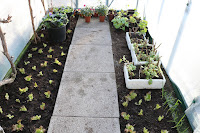COMPANION
PLANTING
I first became aware of the
benefits of companion planting in early apprenticeship times. As an
apprentice gardener we learned
to make the best of spring flower displays as all wallflowers,
daisies, polyanthus, myosotis
and pansies always got an underplanting of tulip bulbs.
Different
heights of tulips were important as you needed the taller Darwin
hybrids to accompany the taller wallflower, but the smaller pansies
and myosotis and other ground hugging bedding got the dwarf double
tulips. In summer the spring flowering bedding plants got replaced
with summer flowering bedding plants all in flower together, and
flower beds tended to be grouped together in well
 |
| Doronicums with Tulip Negrita (purple) and Abba (red) |
manicured lawns. In spring our
tutor Walter Gilmore arranged a trip to St. Andrews Botanic
Gardens.
They had tall
forsythia shrubs covered in a mass of golden yellow flowers and all
 |
| Geraniums and Californian poppies |
underplanted
with the fosteriana tulip, Red Emperor, also known as Mme lefebre
which was also in full bloom. These lessons stayed with me and I soon
began to see many amateur and professional gardeners with great
colourful gardens but very few had grouped plants together with the
same flowering time. There may have had very impressive plants in
full bloom but all at different parts of the garden. I realised the
value of grouping plants with the same flowering time together to
create maximum impact. Another lesson at bulb planting time was to
plant daffodils and tulips in deep tubs with one layer below the
other to maximise impact of flowers. I have now applied these ideas
with a whole range of plants.
The layer style of companion planting
is great with bulbs. I have a bed
 |
| Senecio, Delosperma, Erigeron and Cistus flower together |
devoted
to Oriental Lilies planted quite deep, which flower in mid summer,
but this bed also has a layer of tulips planted above the lilies as
well as a surface layer of grape hyacinths. This way I get a spring
display followed by a summer display. However grape hyacinths can
form a thick layer of bulbs so some periodic thinning is required to
allow the tulips and lilies to push through. Tall
Oriental
lilies are also fine amongst dwarf azaleas. Beds of azaleas have
little impact once the flowering is finished, but the lilies give a
great show in summer.
Woodland fringe areas are also
perfect places to create a spring display with snowdrops, wood
 |
| Berberis darwinii |
anemones, crocus, aconites and
narcissus provided the trees are deciduous. The bulbs are happy to go
dormant once the trees produce leaves and close the canopy. Aconites
can smother the ground in late winter, but they are a great companion
to Cyclamen hederifolium as they emerge just as the aconites die
down. Other good companions have been plants selected for the top of
a wall where it can get a bit dry. Senecio with grey foliage and
yellow flowers is at its best as ground hugging
 |
| Lettuce crop under chrysamthemums |
Delosperma
cooperii with purple flowers is in full flower. These two also flower
at the same time as Cistus and Erigerons. My first tulips to flower
is the Scarlet Baby coming out in March at the same time as a yellow
saxifrage. Then in April and May the yellow Doronicum Little Leo
flowers with purple tulip Negrita and red Abba.
An unusual combination is to plant the orange Berberis darwinii beside your plum, pear and apple trees as the berberis is very attractive to bees which then help to pollinate the other trees.
An unusual combination is to plant the orange Berberis darwinii beside your plum, pear and apple trees as the berberis is very attractive to bees which then help to pollinate the other trees.
On
the allotment I plant lettuce between rows of freshly planted
chrysanthemums and harvest them before the chrysanthemums need the
space.
My climbing rose Dublin Bay
with red flowers covers the wall, but at ground level I have
geraniums and some naturalised
Californian poppies all flowering together.
Wee jobs to do this
week
 |
| John prunes outdoor fuchsia Mrs Popple |
Outdoor
fuchsias are now showing young buds starting to put on some growth.
They have a habit of dieing back in various degrees depending on the
severity of the winter. This year winter has been fairly mild though
a bit wet so dieback is not too serious, but still cut back any shoot
to remove dead ends and other shoots where the bushes have been
growing beyond there allocated space, especially next to footpaths.
END














































